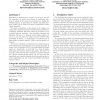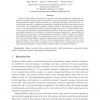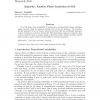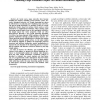267 search results - page 36 / 54 » Anti-Ramsey properties of random graphs |
PODC
2006
ACM
14 years 2 months ago
2006
ACM
Motivated by applications to sensor, peer-to-peer, and adhoc networks, we study the problem of computing functions of values at the nodes in a network in a totally distributed man...
CORR
2006
Springer
13 years 8 months ago
2006
Springer
One property of networks that has received comparatively little attention is hierarchy, i.e., the property of having vertices that cluster together in groups, which then join to f...
TSP
2008
13 years 8 months ago
2008
Markov random fields are designed to represent structured dependencies among large collections of random variables, and are well-suited to capture the structure of real-world sign...
JSAT
2006
13 years 8 months ago
2006
It is well known that satisfiability of random sets of propositional clauses undergoes phase transition while the clause-to-variable ratio of the sets increases. We introduce anot...
ICDM
2010
IEEE
13 years 6 months ago
2010
IEEE
In recent years, many networks have become available for analysis, including social networks, sensor networks, biological networks, etc. Graph clustering has shown its effectivenes...




